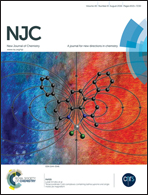A novel ratiometric dual-emission fluorescence magnetic nanohybrid for HIgG immunoassay†
Abstract
In this work, we designed a novel ratiometric dual-emission fluorescence magnetic nanohybrid. Carbon-coated magnetic composite nanoparticles (Fe3O4@C NPs) were prepared through the poly-condensation reaction of glucose under hydrothermal conditions. With appropriate hydrothermal time, temperature and glucose concentration, the glucose was polymerized and carbonized. Then, carbon dots were in situ-synthesized in the carbon shell that gave blue fluorescence due to surface energy trap emission. Furthermore, the surface of Fe3O4@C NPs was endowed with positive charges through modification with poly(diallyldimethylammonium chloride) (PDDA), and the electrostatic forces could bind electronegative CdTe quantum dots (QDs) on the Fe3O4@C NP surface (Fe3O4@C@QDs). The carbon shell preserves the stability of internal Fe3O4 NPs and inhibits the quenching of CdTe QD photoluminescence. To further demonstrate the performance of the nanohybrid as an immunosensor, HIgG was employed as a model target. In a competitive immunoassay, Fe3O4@C@QDs were coated with anti-human IgG. After binding HIgG, HIgG–Au NPs were captured by the remaining unreacted site of anti-human IgG on the Fe3O4@C@QDs nanohybrid surface and quenched the fluorescence of CdTe QDs via fluorescence resonance energy transfer (FRET). The proposed ratiometric dual-emission (carbon dots and QDs) fluorescence magnetic nanohybrid displayed excellent analytical performance for the detection of HIgG in the range of 0.005–100 ng mL−1 with a lower detection limit of 0.0025 ng mL−1.


 Please wait while we load your content...
Please wait while we load your content...